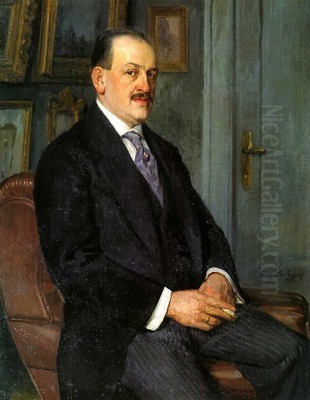
Nikolai Petrovich Bogdanov-Belsky stands as a significant figure in Russian art history, celebrated primarily for his heartfelt and realistic depictions of peasant life, particularly the world of rural children and their education. Active during a tumultuous period spanning the late Tsarist era, the Russian Revolution, and into the mid-20th century, his work provides an invaluable window into the soul of the Russian countryside. His commitment to realism, infused with warmth and empathy, distinguishes his extensive body of work, which continues to resonate with audiences today. Born on December 8 (New Style, December 20), 1868, and passing away on February 19, 1945, his life journey mirrored the dramatic changes sweeping across his homeland.
Humble Beginnings and a Fateful Encounter
Bogdanov-Belsky's origins were modest. He was born an illegitimate son of a farm laborer in the village of Shitiki, Belsky Uyezd, within the Smolensk Governorate of the Russian Empire. His early life was marked by the poverty typical of rural peasantry in late 19th-century Russia. However, his innate talent for drawing did not go unnoticed. A pivotal figure entered his life: Semyon Alexandrovich Rachinsky, a highly educated professor of botany from Moscow University who had renounced his prestigious academic career to establish a unique village school in Tatevo, not far from Bogdanov-Belsky's birthplace.
Rachinsky was more than just an educator; he was a visionary dedicated to nurturing the intellectual and artistic potential of peasant children. He recognized the young Nikolai's artistic gift and took him under his wing. This encounter was transformative, providing Bogdanov-Belsky not only with basic literacy and numeracy but also with his first formal exposure to art and the encouragement to pursue it. Rachinsky's influence would remain a cornerstone of the artist's life and work, with the Tatevo school and its pupils becoming recurring subjects in his paintings.
Formal Artistic Education
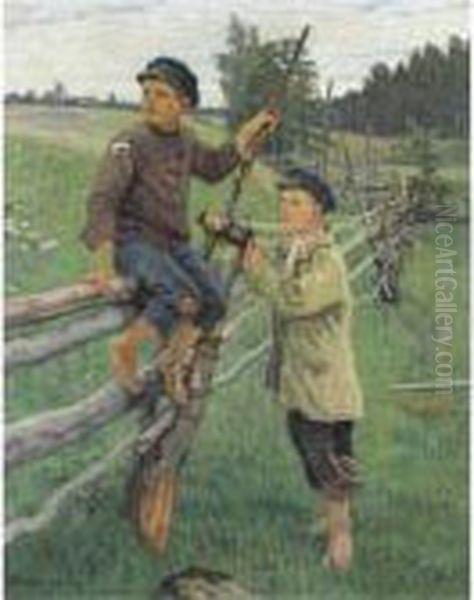
Under Rachinsky's patronage, Bogdanov-Belsky's artistic journey began in earnest. He initially studied icon painting, a traditional and deeply respected art form in Russia, at the school associated with the Troitse-Sergiyev Lavra (Trinity Lavra of St. Sergius), one of Russia's most important spiritual centers, from 1882 to 1884. This grounding in the precise techniques and spiritual depth of icon painting likely contributed to the meticulous detail and emotional resonance found in his later secular works.
Following this, his path led to the prestigious Moscow School of Painting, Sculpture and Architecture, where he studied from 1884 to 1889. This institution was a crucible of Russian Realism. Here, he learned from prominent artists who were shaping the national art scene, including Vasily Polenov, known for his lyrical landscapes and historical scenes; Illarion Pryanishnikov, a master of genre painting depicting everyday life; and Vladimir Makovsky, another key figure in Russian Realism, renowned for his socially conscious genre scenes. The emphasis on direct observation, truthful representation, and socially relevant themes at the Moscow School profoundly shaped his artistic philosophy.
To further refine his skills, Bogdanov-Belsky attended the Imperial Academy of Arts in Saint Petersburg from 1894 to 1895. Although his time there was relatively brief, it placed him within the orbit of the capital's vibrant art world. He became associated with the studio circle of Ilya Repin, arguably the most famous Russian artist of the era and a leading figure of the Realist movement. While Repin wasn't formally teaching at the Academy during that exact period, his influence and mentorship were significant for many younger artists, including Bogdanov-Belsky. The Academy provided exposure to classical traditions and the highest standards of technical proficiency. He also spent time working and studying in private studios in Paris during the late 1890s, absorbing the influences of European art, including Impressionism, which subtly informed his handling of light and color in some later works.
The Spirit of Rachinsky's School
The experience at Semyon Rachinsky's folk school in Tatevo left an indelible mark on Bogdanov-Belsky. He returned to this theme throughout his career, creating some of his most famous and beloved paintings. Rachinsky's progressive educational methods, which combined standard subjects with practical skills, music, and art, aimed to empower peasant children. Bogdanov-Belsky captured the atmosphere of this unique institution with deep affection and understanding.
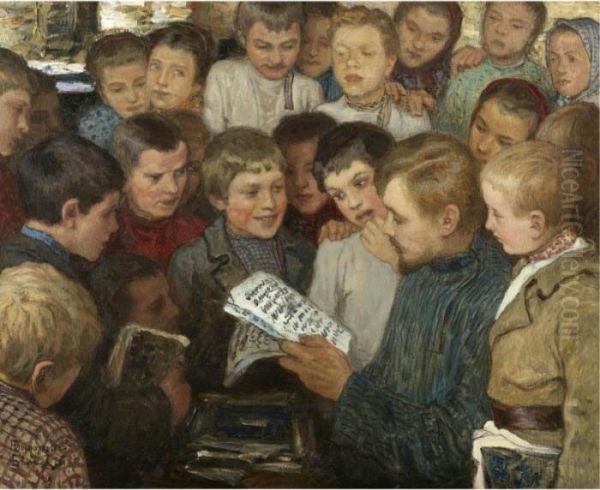
His most iconic work, "Mental Arithmetic. In the Public School of S. A. Rachinsky" (1895), perfectly encapsulates this theme. The painting depicts a group of peasant boys intensely focused on solving a complex math problem presented on a blackboard by Rachinsky himself, who observes them with quiet pride. The concentration on the children's faces, the rustic classroom setting, and the palpable atmosphere of intellectual effort make it a powerful testament to the potential for learning even in humble circumstances. It celebrates both the teacher's dedication and the pupils' eagerness, becoming a symbol of rural education in Russia. Other works, like "At the School Door" (1897), poignantly depict the yearning for knowledge among those perhaps unable to fully access it.
The Peredvizhniki and Russian Realism
In 1895, Bogdanov-Belsky officially joined the Society for Travelling Art Exhibitions, better known as the Peredvizhniki (the Wanderers or Itinerants). This was a natural affiliation, given his training at the Moscow School and his commitment to Realism. Founded in the 1860s by artists like Ivan Kramskoi and Grigory Myasoyedov, the Peredvizhniki sought to break free from the rigid academicism of the Imperial Academy. They aimed to create art that was truthful, accessible, and relevant to the lives of ordinary Russians, often focusing on social commentary, historical narratives, and the beauty of the Russian landscape.
Membership in this influential group placed Bogdanov-Belsky alongside the giants of Russian Realism. He exhibited regularly with the Peredvizhniki, sharing gallery space with artists like Ilya Repin, Vasily Surikov, Isaac Levitan, Alexei Savrasov, and Vasily Perov. His chosen subjects – the lives of peasant children, rural schooling, and genre scenes from the countryside – aligned perfectly with the movement's ethos. His work contributed significantly to the Peredvizhniki's goal of bringing art closer to the people and reflecting the realities of Russian life.
Master of Genre and Portraiture
Bogdanov-Belsky excelled in genre painting, capturing moments of everyday life with sensitivity and detail. His primary focus remained the world of children. He depicted them studying, playing, working, and simply being. Works like "Beginners," "New Tale," and "Country Boys" showcase his ability to convey the innocence, curiosity, and resilience of youth. He avoided sentimentalizing poverty, instead presenting his subjects with dignity and psychological insight. His paintings often tell a story, inviting viewers to contemplate the lives and inner worlds of the individuals portrayed.
His skill was not limited to genre scenes. Bogdanov-Belsky was also an accomplished portrait painter. He created likenesses of various individuals, including intellectuals, fellow artists, and members of the aristocracy. Notably, his talent earned him recognition at the highest levels; he painted a portrait of Tsar Nicholas II, a testament to his standing in the official art world despite his focus on peasant themes. His portraits are characterized by the same realistic precision and psychological depth found in his genre works.
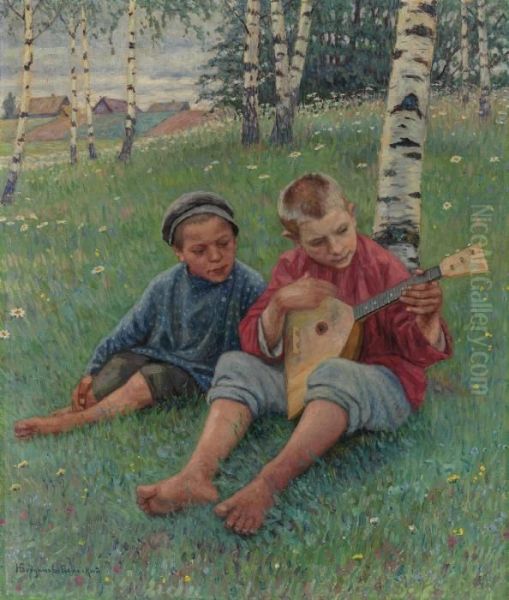
While firmly rooted in Realism, Bogdanov-Belsky's handling of light and color sometimes showed an awareness of Impressionist techniques, particularly in his landscapes and outdoor scenes. He skillfully captured the effects of natural light, adding vibrancy and atmosphere to his compositions. However, this was always subservient to his primary goal of truthful representation, rather than being an end in itself as it often was for French Impressionists like Claude Monet or Pierre-Auguste Renoir. His Russian contemporaries like Valentin Serov and Konstantin Korovin explored Impressionism more fully.
Recognition and Leadership
Bogdanov-Belsky's talent and dedication brought him considerable recognition during his lifetime. He was awarded the title of Academician by the Imperial Academy of Arts in 1903 (Artium Baccalaureus) and became a Full Member ( Действительный член) in 1914, signifying his esteemed position within the Russian art establishment. His works were acquired by major collectors and museums, including the prestigious Tretyakov Gallery in Moscow and the Russian Museum in Saint Petersburg.
Beyond his personal artistic practice, he was actively involved in the artistic community. He was a founding member of the Arkhip Kuindzhi Society, established in 1909 to honor the legacy of the renowned landscape painter Arkhip Kuindzhi, known for his dramatic use of light. Bogdanov-Belsky served as the chairman of the Kuindzhi Society from 1913 to 1918, working alongside other prominent artists like Arkady Rylov to support fellow painters and promote artistic endeavors. This role underscored his commitment to fostering a vibrant artistic environment in Russia.
Emigration and Later Years in Riga and Berlin
The Bolshevik Revolution of 1917 and the subsequent establishment of the Soviet Union brought profound changes to Russia, including its art world. While initially various artistic styles coexisted, the increasing emphasis on Socialist Realism as the officially sanctioned style created difficulties for artists like Bogdanov-Belsky, whose work, though realistic, did not necessarily align with the new political ideology's demands for heroic depictions of workers or revolutionary struggle. His focus on traditional peasant life and education, while humanistic, could be seen as nostalgic or lacking in revolutionary fervor.
Feeling constrained by the changing artistic climate, Bogdanov-Belsky made the difficult decision to leave Russia. In 1921, he emigrated to Riga, the capital of newly independent Latvia. Riga had a significant Russian émigré community and a thriving cultural life. He quickly established himself there, continuing to paint prolifically. His subjects often included scenes from the Latvian countryside, particularly the Latgale region, as seen in works like "Two Women in Latgalian Dress." He also continued painting portraits and scenes of childhood.
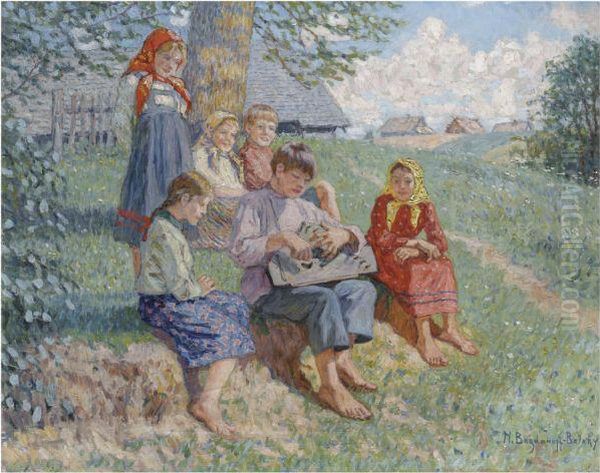
His work was highly appreciated in Latvia. He held successful exhibitions, including a notable one in Copenhagen, Denmark, in 1929 where an entire hall was dedicated to his paintings. His contribution to Latvian cultural life was recognized in 1930 when he was awarded the Order of the Three Stars, Latvia's highest civilian honor. He also became an honorary member of "Fraternitas Arctica," a Russian student corporation based in Riga. During his time in Riga, his studio became a learning center, with artists like Alexei Sergeyevich Vinogradov teaching there before establishing his own school.
As World War II approached and the political situation in the Baltics became precarious with the Soviet occupation in 1940, Bogdanov-Belsky eventually moved to Berlin. Tragically, his life ended there amidst the devastation of the war. He was killed on February 19, 1945, during an Allied bombing raid on the city. He is buried at the Berlin-Tegel Russian Orthodox Cemetery.
Legacy and Collections
Nikolai Bogdanov-Belsky left behind a rich artistic legacy. He is remembered as one of the foremost Russian genre painters of his generation, a master chronicler of rural life, and arguably the most sensitive painter of peasant childhood in Russian art. His works offer a poignant glimpse into a world that was rapidly disappearing, capturing the traditions, challenges, and simple joys of the Russian countryside before the upheavals of the 20th century. His dedication to realism, combined with his empathetic portrayal of his subjects, gives his paintings an enduring human quality.
His works remain highly sought after and are held in numerous prestigious collections. Key paintings reside in Russia's leading museums: the State Tretyakov Gallery in Moscow and the State Russian Museum in Saint Petersburg. Other significant holdings can be found in the National Art Museum of the Republic of Belarus in Minsk, the Smolensk State Museum Reserve, the Latvian National Museum of Art in Riga, and various regional museums throughout Russia and former Soviet republics.
His paintings also appear regularly on the international art market, fetching significant prices at major auction houses like Sotheby's, Christie's, and Bonhams. Works such as "A Difficult Exercise," "Children Playing the Balalaika," and various portraits and landscapes continue to attract collectors interested in high-quality Russian Realist art. The consistent demand for his work underscores his lasting importance and appeal.
Conclusion
Nikolai Bogdanov-Belsky's journey from a poor peasant boy in rural Smolensk to an acclaimed Academician and chronicler of Russian life is a remarkable story of talent and perseverance. Guided by the visionary educator Semyon Rachinsky and trained by masters of Russian Realism like Polenov and Makovsky, he developed a distinctive style characterized by technical skill, keen observation, and profound empathy. As a member of the Peredvizhniki and later as a respected artist in emigration, he remained steadfast in his commitment to depicting the truths of everyday life, particularly the world of children navigating education and rural existence. His paintings serve not only as valuable historical documents but also as timeless explorations of human dignity, the pursuit of knowledge, and the quiet beauty found in ordinary moments. Bogdanov-Belsky secured his place as a beloved and important figure in the rich tapestry of Russian art.